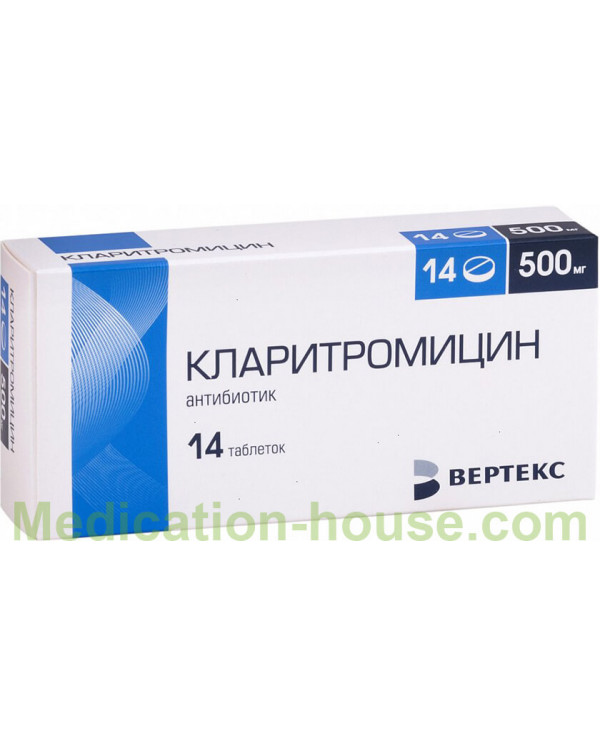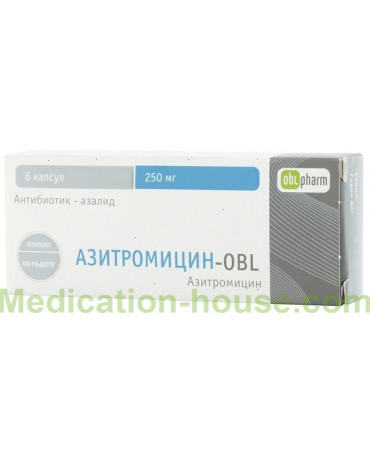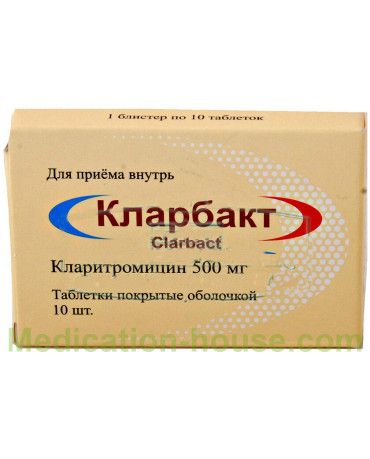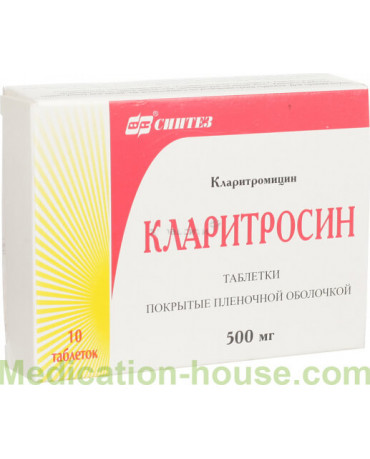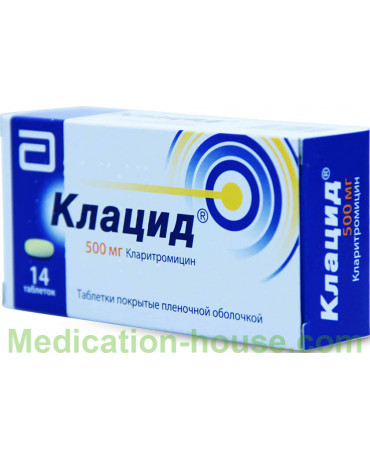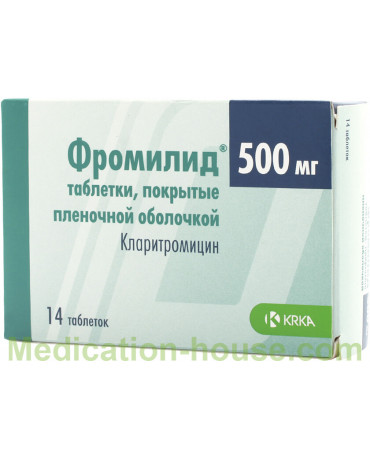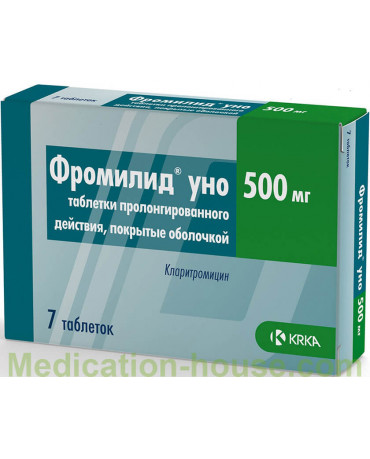Clarithromycin instruction
You can buy Clarithromycin here
Release form and composition
The drug is used orally (from the Latin per os - through the mouth) and parenterally - intravenously drip (in the "droppers"). Clarithromycin is produced in the form of:
capsules (500 and 250 mg);
long-lasting or prolonged action tablets (500 mg each);
conventional tablets (250 and 500);
lyophilized powder from which baby suspension is prepared;
solution for intravenous drip.
The tablets contain the active component clarithromycin, as well as additional components: MCC, potato starch, pregelatinized starch, low molecular weight PVP, colloidal silicon dioxide, magnesium stearate, sodium lauryl sulfate.
Pharmacological effect
The active ingredient Clarithromycin acts bacteriostatic and bactericidal. The drug is active in relation to:
Gram-positive bacteria - Corynebacterium spp., Staphylococcus spp., Listeria monocytogenes, Streptococcus spp .;
Gram-negative bacteria - Haemophilus influenzae, Helicobacter pylori, Haemophilus ducreyi, Bordetella pertussis, Neisseria gonorrhoeae, Moraxella catarrhalis, Neisseria meningitidis, Borrelia burgdorferi;
Intracellular microorganisms - Ureaplasma urealyticum, Chlamydophila pneumoniae, Chlamydia trachomatis, Legionella pneumophila, Mycoplasma pneumoniae;
Anaerobic bacteria - Peptococcus spp., Bacteroides melaninogenicus Eubacterium spp., Propionibacterium spp., Clostridium perfringens.
Clarithromycin according to the instructions is also active against Mycobacterium spp. (except Mycobacterium tuberculosis) and Toxoplasma gondii.
There are quite a few Clarithromycin analogues that have the same therapeutic effect.
Indications for use
It is used to treat infectious and inflammatory diseases caused by causative agents that are sensitive to clarithromycin, namely:
odontogenic infections;
skin and soft tissue infections;
infections of the upper respiratory tract and upper respiratory tract (tonsillofaringitis, otitis media, acute sinusitis);
mycobacterial infections (M.avium complex, M.kansasii, M.marinum, M.leprae) and their prevention in AIDS patients;
lower respiratory tract infections (acute bronchitis, exacerbation of chronic bronchitis, community-acquired bacterial and atypical pneumonia);
Helicobacter pylori eradication in patients with duodenal ulcer or stomach ulcer (only as part of combination therapy).
Contraindications
A history of a prolonged QT interval, ventricular arrhythmia, or ventricular pirouette tachycardia; hypokalemia (risk of prolonged QT interval); severe liver failure, occurring simultaneously with renal insufficiency; cholestatic jaundice / hepatitis in history, developed with the use of clarithromycin; porphyria; I trimester of pregnancy; lactation period (breastfeeding); simultaneous administration of clarithromycin with astemizole, cisapride, pimozide, terfenadine; with ergot alkaloids, for example, ergotamine, dihydroergotamine; with oral midazolam; with HMG-CoA reductase inhibitors (statins), which are largely metabolized by the CYP3A4 isoenzyme (lovastatin, simvastatin), with colchicine; with ticagrelor or ranolazine; Hypersensitivity to clarithromycin and other macrolides.
Precautions should use clarithromycin in patients with moderate to severe renal failure; moderate and severe liver failure, with coronary artery disease, severe heart failure, hypomagnesemia, severe bradycardia (less than 50 beats / min); simultaneously with benzodiazepines, such as alprazolam, triazolam, midazolam for intravenous administration; simultaneously with other ototoxic drugs, especially aminoglycosides; simultaneously with drugs that are metabolised isoenzymes CYP3A (including carbamazepine, cilostazol, cyclosporine, disopyramide, methylprednisolone, omeprazole, oral anticoagulants, quinidine, rifabutin, sildenafil, tacrolimus, vinblastine, simultaneously with inductors CYP3A4 (including rifampicin , phenytoin, carbamazepine, phenobarbital, St. John's wort); simultaneously with statins, the metabolism of which does not depend on the CYP3A isoenzyme (including fluvastatin); simultaneously with blockers of slow calcium channels metabolized by the isoenzyme comrade CYP3A4 (including verapamil, amlodipine, diltiazem); simultaneously with antiarrhythmics of class I A (quinidine, procainamide) and class III (dofetilide, amiodarone, sotalol).
Use during pregnancy and lactation
The use of Clarithromycin in the first trimester of pregnancy is absolutely contraindicated.
The use of the drug on the rest of the pregnancy is possible only in exceptional cases.
The use of Clarithromycin during breastfeeding should occur only after complete rejection of it.
Instructions for use
The instructions for use indicate that Clarithromycin is applied orally, regardless of the meal and milk. It is recommended to adhere to the prescribed treatment regimen. The missed pill must be taken as soon as possible, however, if the time for taking the next pill is almost over, you cannot take a double dose.
If a different scheme is not prescribed by a doctor, Clarithromycin is taken in 250 mg 2 p / day (for children over 12 years old and adults). According to the testimony you can take 500 mg 2 p / day. The course of treatment is 5-14 days.
In renal insufficiency Clarithromycin is prescribed in a dose that depends on creatinine clearance:
Clarithromycin 500 mg: with clearance> 30 ml / min - 500 mg 2 p / day; with clearance <30 ml.min - the initial dose of saturation - 500 mg, then - 250 mg 2 p / day.
Clarithromycin 250 mg: with clearance> 30 ml / min - 250 mg 2 p / day; with clearance <30 ml / min - 250 mg 2 p / day.
For infections caused by mycobacteria, it is recommended to use Clarithromycin 500 mg 2 p / day. Perhaps the appointment in combination with other antibacterial agents. With a widespread mycobacterial infection in patients with AIDS, drug therapy is continued until the microbiological and clinical state.
For the eradication of Helicobacter pylori infection, the following treatment regimens are used:
Three drugs - Clarithromycin 500 mg 2 p / day on the background of treatment with proton pump inhibitors (pantoprazole, lansoprazole, omeprazole or others) and amoxicillin 1 g 2 p / day (10 days).
Two drugs - Clarithromycin 500 mg 3 p / day on the background of treatment with proton pump inhibitors (pantoprazole, lansoprazole, omeprazole, etc.) - 14 days.
As a prevention for the threat of mycobacterial infection, Clarithromycin is prescribed 500 mg 2 p / day.
In the treatment of infections of the tooth-jaw system - 250 mg 2 p / day (5 days).
Side effects of Clarithromycin
During therapy may develop disorders of some body systems:
Skin: often - intense sweating; frequency is not installed - hemorrhage, acne;
The body as a whole: infrequently - chills, chest pain, malaise, asthenia, hyperthermia, fatigue;
Respiratory system: infrequently - nasal bleeding, asthma, pulmonary thromboembolism;
Musculoskeletal system: infrequently - myalgia, musculoskeletal stiffness, muscle spasm; frequency is not installed - myopathy, rhabdomyolysis;
Hematopoietic system: infrequently - thrombocythemia, leukopenia, eosinophilia, neutropenia; frequency not established - thrombocytopenia, agranulocytosis;
Blood coagulation system: infrequently - prolongation of prothrombin time, increase in the value of the international normalized ratio (MHO);
Urinary system: infrequently - change in the color of urine, increasing the concentration of creatinine; frequency not established - interstitial nephritis, renal failure;
Parasitic and infectious diseases: infrequently - gastroenteritis, candidiasis, cellulitis, secondary infections (including vaginal); frequency not established - erysipelas, pseudomembranous colitis;
Nutrition and metabolism: infrequently - loss of appetite, anorexia, changes in the ratio of albumin-globulin, increasing the concentration of urea;
Cardiovascular system: often - vasodilation; infrequently - atrial fibrillation, cardiac arrest, prolongation of the QT interval on an electrocardiogram (ECG), atrial flutter, extrasystole; frequency not established - ventricular tachycardia, including the type of "pirouette";
Sense organs: often - taste perversion, dysgeusia; infrequently - ringing in the ears, vertigo, hearing loss; frequency not established - agevziya, deafness, anosmia, parosmia;
Nervous system: often - insomnia, headache; infrequently - dyskinesia, loss of consciousness, dizziness, tremor, drowsiness, irritability, anxiety; frequency not established - psychotic disorders, convulsions, nightmares, hallucinations, confusion, depression, depersonalization, disorientation, mania, paresthesia;
The digestive system: often - pain in the abdomen, nausea, diarrhea, dyspepsia, vomiting; infrequently - proctalgia, esophagitis, gastritis, flatulence, gastroesophageal reflux disease, stomatitis, dry mouth, glossitis, constipation, abdominal distension, belching, elevated bilirubin concentration in the blood, increased activity of alanine aminotransferase (ALT), asbestos and transfusion of the bloodstream, increased swelling, alanine aminotransferase (ALT) (GGT), alkaline phosphatase (alkaline phosphatase), lactate dehydrogenase (LDH), cholestasis, hepatitis, including hepatocellular and cholestatic; frequency not established - cholestatic jaundice, discoloration of the teeth and tongue, acute pancreatitis, liver failure;
Allergic reactions: often - rash; infrequently - maculo-papular rash, hypersensitivity, anaphylactoid reaction, bullous dermatitis, urticaria, pruritus; frequency not established - toxic epidermal necrolysis, angioedema, anaphylactic reaction, Stevens-Johnson syndrome, drug rash with systemic symptoms and eosinophilia (DRESS syndrome).
Overdose
With the right drug intake, overdose cases are quite rare. In case of accidental ingestion of a large number of tablets or a significant excess of the recommended daily dose, the patient develops signs of overdose. They are expressed in strengthening the above-described side effects and the development of severe disorders of the liver.
In this case, the patient is taken to a doctor, where he is washed in the stomach, sorbents are led inside, and symptomatic treatment is performed if necessary. Hemodialysis will not be effective.
special instructions
Caution means prescribed when taking drugs, the metabolism of which takes place in the liver.
There is cross-resistance between antibacterial drugs that belong to the group of macrolides.
It should be borne in mind that the manifestation of severe diarrhea may be associated with pseudomembranous colitis.
If a patient is diagnosed with chronic diseases, it is imperative that he controls the serum enzymes.
In the process of antibiotic therapy, the normal intestinal microflora changes; therefore, the likelihood of superinfection caused by resistant microorganisms should be taken into account.
Children may be given a suspension, the active substance of which is clarithromycin.
Drug interactions
The drug can not be combined with taking cisapride, pimozide, terfenadine.
Cross-resistance between clarithromycin, lincomycin and clindamycin is possible.
The drug reduces the absorption of zidovudine, which requires adherence to the interval between doses for 4 hours.
Clarithromycin increases the concentration in the blood of drugs metabolized in the liver with the help of cytochrome P450 enzymes, indirect anticoagulants, carbamazepine, theophylline, astemizole, cisapride, terfenadine (2-3 times), triazolam, midazolam, cyclosporine, disipyramide, lyphidin, and triazolam, midazolam, cyclosporine, dysopiramide, lyphidin, and triazolam; digoxin, ergot alkaloids and other means.
Reviews
We picked up some feedback from people about Clarithromycin:
Victoria
Drinking immediately after a meal or even while eating ... yesterday was the first day of ingestion from Helic ... in the morning on tooshchak an hour before eating — omez, 20 minutes before a meal — denol, immediately after eating amoxicillin + kloritrositsin, in the morning bitterness in the mouth and almost black stools, like coal tablets ... for now. Today I will continue to drink according to the scheme, see what happens next. My husband has been drinking for 4 days ... in general, no changes except a black chair at the very beginning ... All health.
Alexander
When you need to take clarithromycin, it does not matter what your sore, pay special attention to your diet. Do not eat before the reception, eat dietary food, take omez to extinguish excess gastric juice, denol, so that the stomach and intestines are covered with a protective whip, as well as bifiform with food, so that the microflora is restored as soon as possible and that's it. Be careful and consistent - you still destroy the living creatures in themselves, then to recover, and not just take a few pills, assuming that they will do everything once or twice and nothing more is required. I take almost a week and everything is fine with me, there are no side effects.
Artem
He caught ARD, the therapist prescribed Clarithromycin. My wife read about him on the Internet, said that the reviews about him were simply terrible and tried to dissuade me from accepting him. I, of course, did not obey. It turned out that nothing. After two steps, I began to feel bitterness in my mouth, which eventually passed. Packing 6 tablets over, bought two more. The bitterness became constant, nausea was added to it. I hardly slept at night, and when I fell asleep, I had some nightmares. Whether for medication, or for insomnia, the head for two days thought very bad.
Pauline
We prescribed his ENT son for otitis. On the third day, an ambulance was caused to the child — very severe pain in the ears began. Before his reception, otitis was asymptomatic. There was only a slight inflammation. Clarithromycin was immediately canceled and we were advised to never use it again. Then he was prescribed to her husband for sinusitis - also did not help, in the end he was injected with antibiotics intramuscularly.
Storage conditions
The tablets are kept in a dark, cool place where children have no access. The shelf life of the drug is 4 years, at the end of which the drug is discarded.
Terms of sell
You don't need a prescription to buy Clarithromycin.

